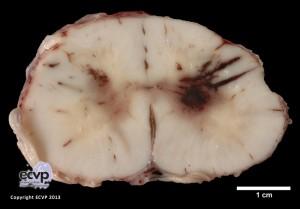
Signalment: Horse, mare, 24 years.
Diagnosis: Lumbar spinal cord, grey matter: malacia and hemorrhage, acute, multifocal, moderate to severe (consistent with post anesthetic acute hematomyelia of the horse)
Description: In the cross section of the lumbar spinal cord multifocal to coalescing areas of dark red discoloration are present. Affected areas are located in the right dorsal horn and the right ventral root of the lumbar grey matter with a lighter reddish discoloration being present in the left dorsal horn.
Comments: Following supine positioning during anesthesia, post-operative clinical symptoms included paraplegia of the hind-limbs and consecutive lateral recumbency. The mare was euthanized with poor prognosis. Necropsy revealed mild to severe, multifocal, acute malacia and hemorrhage in the grey matter of the caudal thoracic, the lumbar as well as the cranial sacral spinal cord. Histology confirmed multifocal, acute malacia and hemorrhage which was moderately present in T 17 and 18, mild to severely in the lumbar and sacral grey matter. Severe, multifocal, acute congestion, few hyaline vascular thrombi and mild, focal, submeningeal hemorrhage accompanied the lesions. Additionally, severe, multifocal, acute congestion in the medulla oblongata, cervical and thoracic grey matter up to T 16 was seen.
Post anesthetic hemorrhagic myelopathy is a rarely encountered but progressive and devastating neuropathological condition due to a dissecting, blood-filled cavity spreading cranially and caudally from the site of trauma and is primarily located in the grey matter which shows an increased susceptibility to hemorrhage and hypoxia due to greater vascularity and metabolic rate. A predisposition of the thoraco-lumbar region may exist as seen in this case. Other possible causes of hematomyelia are severe type I disk herniation, thromembolism and hypovitaminosis E.
Image by: Alexander Weiss, Department of Veterinary Pathology, Freie Universität Berlin
Author: Nancy Erickson, Department of Veterinary Pathology, Freie Universität Berlin
